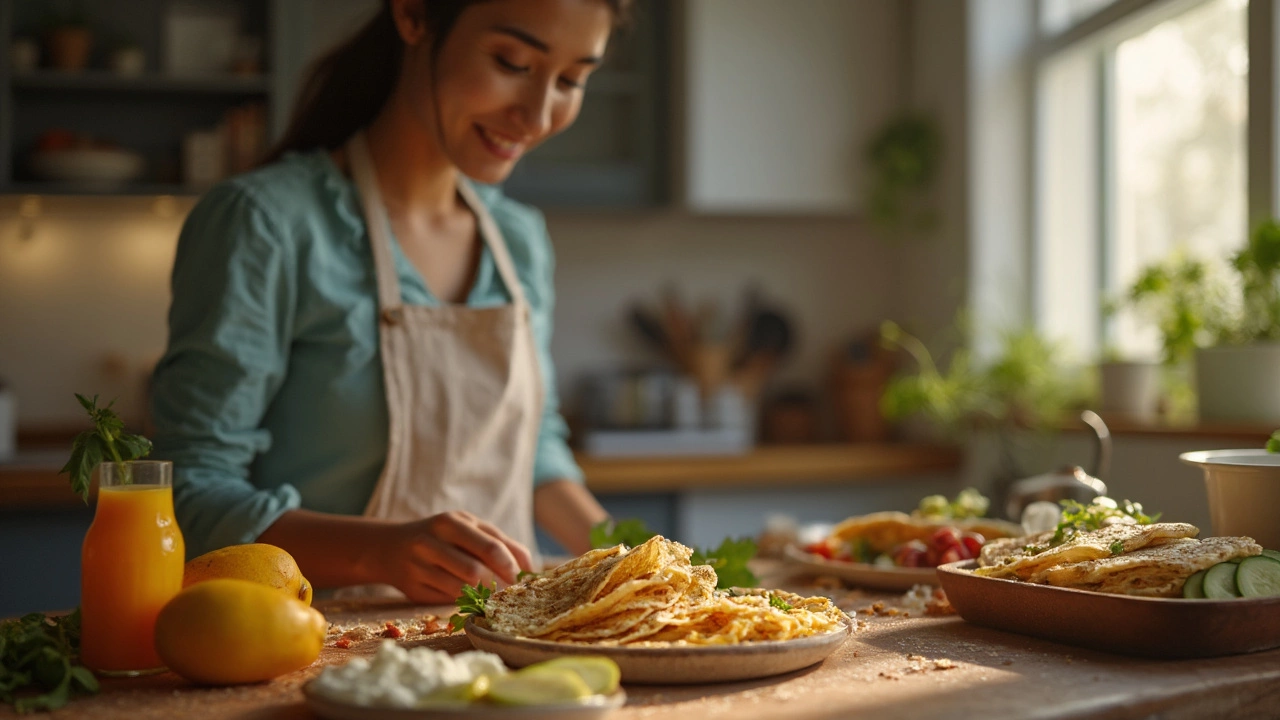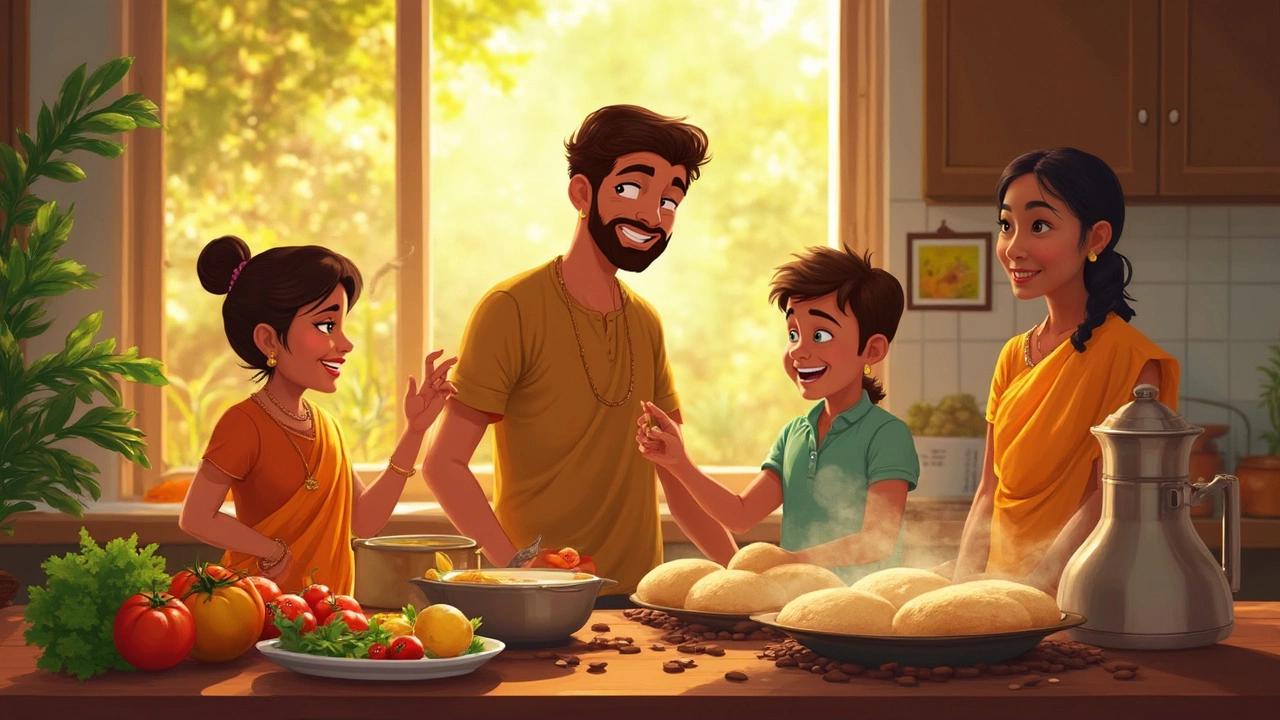Nothing gets you out the door quite like a good Indian breakfast—but picking the healthiest one? That can get tricky, especially with so many fried, buttery, or carb-loaded classics tempting you. It’s not always about cutting out everything you love. It’s about what you choose most mornings and how you can tweak your favorites for better energy and gut health.
Did you know breakfasts in India are already built on some solid nutrition science, like fermented foods and plant proteins? A classic dosa isn’t just crunchy comfort food; made from lentils and rice, it actually gives you amino acids and gut-friendly bacteria. Poha? It’s full of easy carbs and iron, especially if you toss in peas and peanuts. The trick is picking versions that don’t drown in oil or come topped with mountains of ghee—even though we all love a little indulgence sometimes.
- Why Breakfast Matters in India
- Breaking Down the Healthiest Indian Breakfast Options
- Quick and Nutritious Breakfast Ideas
- Tips for a Balanced Start Every Day
Why Breakfast Matters in India
Start your day hungry and your body will notice—sluggish brain, low mood, cranky stomach, all that fun stuff. In a country where mornings can mean everything from catching a local train to prepping for online meetings, a proper breakfast isn’t just tradition—it’s fuel. Indian routines are built around strong breakfasts for a reason.
The real deal? Skipping breakfast in India is linked to lower focus at work or school, not to mention cravings for deep-fried snacks before lunch. One study from AIIMS in Delhi found that students who ate a fiber-rich healthiest indian breakfast performed 20% better on morning tests compared to those who skipped or grabbed just chai and biscuits.
Indian breakfasts are different from Western cereal bowls. Folks here depend on combos of grains, pulses, veggies, and spices—all working together for steady energy instead of a sugar rush. For example, a plate of upma or idli gives you protein, fiber, and some good carbs. No crash an hour later.
Take a look at what’s usually found in a regular Indian breakfast, and how these stack up:
| Common Breakfast | Protein (g) | Fiber (g) | Why It Works |
|---|---|---|---|
| Idli Sambar | 8 | 3 | Fermented, gut-friendly, low fat |
| Poha | 4 | 2 | Light, quick, iron from flattened rice |
| Upma | 5 | 2 | Semolina & veggies keep you full |
| Pesarattu (Moong Dal Dosa) | 8 | 3 | High protein, good for sustained energy |
See those protein and fiber values? They slow down digestion so you won’t go snack-hunting before noon. So when you’re wondering why finding the quick indian breakfast matters, it’s not just about tradition—it keeps crazy energy dips, mood swings, and overeating at bay for real people, not just health nuts.
Breaking Down the Healthiest Indian Breakfast Options
When you think about the healthiest Indian breakfast, it helps to look at what actually goes into the usual suspects. A smart breakfast fuels your day, balances blood sugar, and packs in fiber, protein, and good fats. Some Indian classics tick most of these boxes—if you prep them right.
Let’s talk about poha, a go-to in western India. Flattened rice cooks super fast, is gentle on the stomach, and actually has more iron than you’d expect, especially if it's cooked in a simple way and not overloaded with potatoes or oil. Toss in nuts, peas, or sprouts for more protein and crunch.
Idli and dosa aren’t just Southern staples; they’re healthy because they’re steamed or pan-cooked, fermented, and use rice with urad dal (black gram). That gives you a decent combo of carbs and protein—plus, the fermentation helps your gut bacteria. Thinking about calorie count? A pair of medium idlis with sambar comes in around 200 calories with almost no oil.
If you’re all about upma, you’re already on the right track. Semolina or rava is pretty easy to digest, and upma is super versatile. Add carrots, peas, beans, or even leftover veggies to boost both taste and vitamins. The best part? Upma fills you up without weighing you down.
North India brings parathas into the game. But to keep it healthy, ditch butter and go with very little oil. Use whole wheat flour and stuff the flatbreads with veggies like spinach, methi, or grated carrots for extra fiber. Pair it with low-fat curd instead of heavy pickles or cream.
Protein is something people sometimes miss at breakfast. Try a simple moong dal cheela. It looks like a pancake, is made with split green gram, and takes less than 20 minutes. It’s a plant protein bomb and tastes awesome with coriander chutney or plain yogurt on the side.
If you’re serious about quick indian breakfast options, here's a simple look at how some dishes stack up:
| Dish | Calories (avg) | Protein (g) | Cooking Time |
|---|---|---|---|
| Idli (2 pcs) | 120 | 4 | 10 min (ready batter) |
| Poha | 250 | 5 | 15 min |
| Moong Dal Cheela | 140 | 7 | 20 min |
| Upma | 190 | 4 | 15 min |
Don’t forget, chutneys and sambar can really boost nutrition. Coconut, tomato, and coriander chutneys bring in antioxidants. Sambar adds fiber and plant protein from lentils plus veggies. If you want the top combo: idli with sambar and coconut chutney is hard to beat for a nutritious breakfast india experience.

Quick and Nutritious Breakfast Ideas
If you’re in a rush but still want a healthiest indian breakfast, you don’t have to settle for plain toast or a soggy bowl of cornflakes. There are loads of fast dishes in Indian kitchens that tick all the right boxes when you know a couple of easy tricks.
- Moong Dal Chilla: This one is a protein hero. Blend soaked moong dal (split green gram) with ginger, chili, and spices, then cook on a nonstick pan. Takes around 10 minutes. Filled with fiber and protein, and it’s gluten free.
- Vegetable Poha: This Maharashtrian classic is ready in under 20 minutes. Flattened rice cooks fast, and when you add peas, carrots, tomatoes, peanuts, and a squeeze of lemon, you’re not just eating carbs—you’re adding vitamins and good fats, too. Use minimal oil for best results.
- Oats Upma: Upma is a south Indian staple, but swap out suji (semolina) for oats to give it more fiber. Toss in onions, tomatoes, and peas. It helps manage blood sugar and keeps you full longer after breakfast.
- Idli with Sambar: Idlis are steamed (low-cal) and made from fermented rice and urad dal. Pairing with sambar gives protein, fiber, and extra veggies for a nutrient punch. Steam a batch and store them—reheat for tomorrow’s meal.
If you’re trying to boost the nutrition of your quick indian breakfast, some small swaps are game changers:
- Throw in handfuls of greens like spinach or methi leaves to batters and upmas.
- Switch white bread or pav to whole wheat or multigrain versions.
- Mix seeds like flax or chia into your chutneys or sprinkle on top for a crunch and to pack in omega-3s.
| Dish | Calories | Protein | Fiber |
|---|---|---|---|
| Moong Dal Chilla (2) | 175 | 11g | 5g |
| Vegetable Poha | 210 | 5g | 4g |
| Oats Upma | 190 | 6g | 5g |
| 2 Idlis with Sambar | 180 | 7g | 4g |
Notice how the options here have balanced macros, not just carbs. Protein hits are higher with dal-based recipes, while fiber jumps up with oats and veggies. That’s exactly what keeps you feeling good until lunch.
Tips for a Balanced Start Every Day
You don’t have to overhaul your whole routine to have a healthiest Indian breakfast. Even small tweaks can make a huge difference in your energy and how full you feel till lunch. The key is to mix up what’s on your plate—think protein, fiber, and good fats, not just carbs.
Pair wisely: Team your idlis or dosas with a bowl of sambar or a handful of sprouts. You get more protein and fiber, which keeps blood sugar stable. If you reach for poha, stir in boiled peanuts, chopped veggies, or even paneer cubes.
Eggs are your friend: If you eat eggs, a veggie-loaded omelette with whole-wheat toast or leftover sabzi is an easy win. A single egg packs about 6 grams of protein, which is solid for a busy morning.
Here’s a quick cheat sheet to build a solid breakfast:
- Protein: Moong dal chilla, paneer paratha, Greek yogurt, sambar, sprouts
- Good carbs: Poha with veggies, upma, whole wheat breads, millet dosas
- Healthy fats: Peanuts, seeds, a drizzle of ghee or olive oil
- Fiber boost: Add spinach, carrots, or tomatoes to upma, or some grated lauki to paratha stuffing
And don’t ignore water or chai—being even slightly dehydrated will drag down your energy.
Here’s a look at how a few popular choices stack up for macronutrients per serving:
| Breakfast | Protein (g) | Fiber (g) | Approx. Calories |
|---|---|---|---|
| Plain Idli (2 pcs) + Sambar | 7 | 4 | 180 |
| Poha w/ Veggies & Peanuts | 5 | 3 | 200 |
| Moong Dal Chilla (2 pcs) | 9 | 5 | 180 |
| Paneer Paratha (1 pc) | 8 | 5 | 230 |
Quick tip: Prep batters or veggies the evening before. Slicing onions and grating carrots at night shaves off those early morning minutes. You can even soak your dal or rice for dosas a day or two ahead, and store it in the fridge.
And if you’re running late for work or class, a fruit with a small handful of roasted chana or a homemade smoothie (think curd, spinach, banana, chia seeds) will save you from skipping breakfast altogether. Not fancy, just real food that gets the job done.
